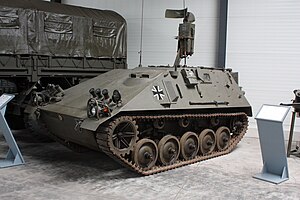Radar reconnaissance tank 91-2
| Radar reconnaissance tank 91-2 | |
|---|---|

Radar reconnaissance tank 91-2 with extended radar in the Munster tank museum |
|
| General properties | |
| crew | 4 men |
| length | 4.51 m |
| width | 2.34 m |
| height | 1.60 m (with radar folded) |
| Dimensions | 8.0 tons |
| Armor and armament | |
| Armor | 8–15 mm armored steel (tub) |
| Main armament | unarmed |
| Secondary armament | Smoke throwing system with 2 × 3 throwing cups |
| agility | |
| drive |
Six cylinders - V-engine , Otto engine type Hotchkiss 121 kW (164 hp) |
| Top speed | 58 km / h |
| Power / weight | ~ 21 hp / t |
| Range | approx. 400 km (road) |
The radar reconnaissance tank 91-2 (also SPz radar reconnaissance or Type 91-2 for short ) was the Bundeswehr's first tank reconnaissance radar , which was introduced in the PzArtBtl's observation batteries in the 1960s .
History of origin
The development of the radar reconnaissance tank 91-2 took place from 1957 to 1959 on the basis of the IFV for short . The production represented a conversion measure from a medical tank SPz 2-2 , which was carried out from 1959 to 1967. A total of 70 radar tanks were built, which were used in the German army until 1987 and were finally replaced by the "RASIT" tank reconnaissance radar in the 1980s .
technology
The radar reconnaissance tank is based on the armored personnel carrier for short , which was part of the basic equipment of the Bundeswehr and had the same drive technology. It was a six-cylinder V-Otto engine from Rolls-Royce , which with a displacement of 4678 cm³ could produce an output of 121 kW (164 hp). However, this was not sufficient to supply the radar system and the enhanced radio equipment. For this reason, an external power generator was installed in a rectangular box on the left half of the rear door.
radar
The Type 91-2 used the medium-range battlefield surveillance radar AN / TPS-33 (a) from the American manufacturer Admiral Corporation . Installed in the rear of the vehicle, the radar antenna can be manually extended about 1.10 meters above the top edge of the vehicle by means of a steel bar and thus enables the reconnaissance of people or groups of people at distances of up to 5000 meters and of tracked and wheeled vehicles at distances of up to 18,000 meters . The radar device operates at a frequency of 9375 MHz and has the aforementioned maximum detection range of almost 18 km with an HF power of 4 kW. Before the introduction of the "RASIT" system, the battlefield radar AN / TPS-33a served as an interim solution based on the TPz Fuchs .
Web links
- Radar Reconnaissance Tank 91-2 website
- Armored personnel carrier Kurz SPz 91-2 Radar reconnaissance vehicle Walk Around Page
Individual evidence
- ↑ SPz 91-2 “Radar carrier” on spz-kurz.com
- ^ A b c d Karl Anweiler: The wheeled and tracked vehicles of the Bundeswehr. 1956 until today. Bechter coin 1998. Augsburg. P. 293.
- ↑ TANKOGRAD Publishing: Schützenpanzer short, Hotchkiss / long, HS 30. Publication number 5018. 64 pages.
- ↑ TPN - Ground, Transportable; Radar; Navigation Aid - Radar Descriptions (English)
- ^ Association of the United States Army: Army, Volume 16, 1966
- ↑ IFV short, Hotchkiss (Bw) radar tank AN / TPS-33 (IFV 91-2)
